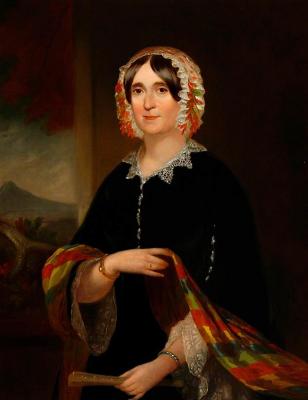Mary Ann Porteus Receipt Book, 1814
View Catalog Record
[Library Title: Manuscript Recipe Book]
[Library Title: Manuscript Recipe Book]
Manuscript Cookbooks Survey Database ID#
1287Place of Origin
England ➔ Suffolk ➔ Bury St. EdmundsDate of Composition
1814Description
This quarto manuscript comprises 90 leaves of culinary and medical recipes. On the first leaf, the book is titled "Culinary Receipts," signed M. A. Porteus, and dated 5 September 1814. The book is written back-to-back. Culinary recipes appear on 60 pages written from the front of the volume, while medical and household recipes are written on 30 pages starting from the back of the notebook. Eight additional recipes on personal stationery are loosely inserted into the book. Also inserted is a late-Victorian or Edwardian color drawing of a serving maid with a tea tray.
Mary Ann Porteus (1794-1876) was the eldest daughter of the Reverend Robert Porteus, grandnephew of Dr. Beilby Porteus, Bishop of London. In 1820 she married the lawyer Henry James Oakes, and they had four children. The family appears in records associated with Bury St. Edmunds, in Suffolk, England. A portrait of Mary Ann, painted in 1854, is now part of the collections of the St. Edmundsbury Museum of West Suffolk.
Initially, Porteus inserted the culinary recipes that she collected under headings such as "Puddings," "Pyes, Cakes, Bread Etc.," "Cheeses, Custards, Jellies, Ice," "Wines," "Pickles Etc.," and "Soups, Broths, Etc." However, she appears to have added later recipes to book in the order in which she received them, without organizing them under the headings. The culinary recipes cover many of the favorite dishes of the time, including mock turtle soup, a “floating island," lemon cheese cake, French bread [meaning enriched bread, not bread as the French made it], orange marmalade, cowslip wine, pickled cabbage, stewed oysters, fish sauce, lobster sauce, potted shrimps, calf's foot jelly, cheese fondu, lavender water, and yeast. The book provides numerous recipes for ice creams, gelatin jellies, and custards, all popular desserts of the day.
The culinary entries tend to be concisely written, like this recipe for lemon custard: "Take the juice of 3 lemons, with 4 oz of fine sugar, heat a pint of cream scalding hot, pour it through a tea pot near a yard high - your lemon juice to be out into a soup plate, and it is best made 10 or 12 hours before you use it." The purpose of pouring the hot cream from on high into the acidic lemon juice was to induce a frothy head, which would firm up upon standing.
The medical recipes include treatments for coughs, colds, sore throats (including one that uses spermaceti), stomach ulcers, wasp stings, lumbago, toothache, burns, consumption, gout, nose bleeds, sprains, and nervous headache. Also included is a cure for cancer, related by a Mrs. Shakely, which entails boiling dried figs in milk. The figs are split and applied hot to the affected area, and half of the milk is drunk by the patient. The back section of the book also provides instructions for preparing bath salts, teeth cleansers, bitters, cooling drinks, and cold cream, and for fixing chalk drawings.

